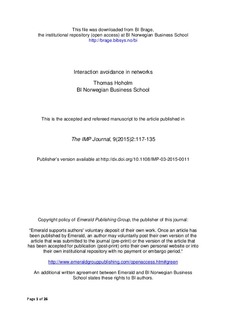| dc.description.abstract | Abstract
Purpose: This paper develops the case for studying non-interaction in networks, particularly instances of intentional avoidance of interaction.
Design: The paper is based on the analysis of instances of interaction avoidance across four case studies in medical technology development, food product development, food distribution network change, and regional innovation in construction.
Findings: Some answers are provided to the questions of why and how actors may seek to avoid interaction. Five modes of interaction avoidance are identified and outlined. Within these modes, interaction avoidance took place in order to protect knowledge, enforce progress, economise in business networks, avoid wasting resources, and maintain opportunities respectively. This list is not seen to be exhaustive of the theme, and further studies are encouraged.
Originality: Few inter-organizational network studies have dealt explicitly with interaction avoidance or non-interaction. | nb_NO |
